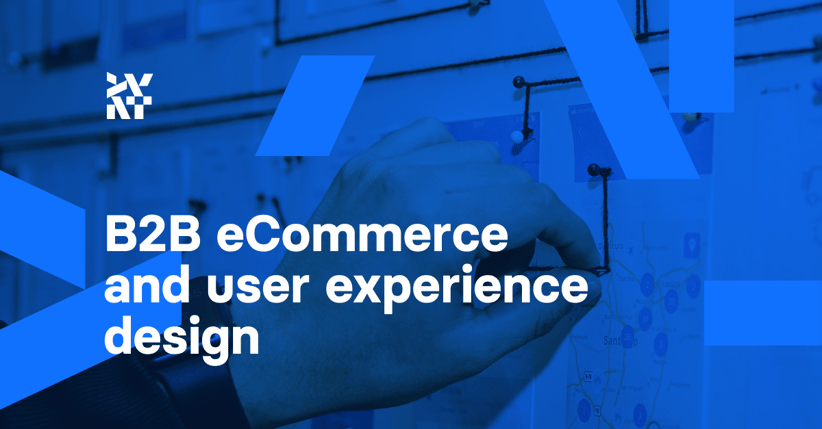Over the last couple of years, we’ve been witnessing a gradual transition from traditional shopping in physical stores to eCommerce platforms. A growing number of businesses have started on a path to digital transformation by incorporating digital purchasing, remote work, or technologies driven by artificial intelligence (AI).
More and more customers are starting to use digital interfaces instead of talking to salespeople. That means that those interfaces need to be easy to use and functional enough to replace a typical interaction with a real person. This is where eCommerce meets user-experience design (UXD), a field that is concerned with providing accessible, smooth, and seamless experiences to users of digital products.
The COVID-19 pandemic only accelerated this change. Online shopping practically exploded in the days of lockdowns and social distancing, and even in the post-pandemic world, this trend is clearly not going to go away. According to findings from McKinsey research, the pandemic accelerated several years of eCommerce adoption into just a couple of months.
What’s more, 96% of buyers plan to continue leveraging online procurement in the long term. It’s also forecasted that by 2040, 95% of retail purchases are likely to be made online and traditional retail may hardly matter.
Since using eCommerce has become a daily practice around the world, it's not surprising that consumers are now expecting a similar level of experience when procuring for a business. Retailers who don’t transform to meet these demands are facing the risk of losing relevance with their customers.
Unfortunately, adjusting to this new landscape isn’t as simple as copying the practices that were designed for B2C into a B2B model. The field of UXD teaches us that a successful product or service needs to be designed with the user and specific context in mind. Over the years of designing for both consumers and businesses, we found that there are significant differences in customer behavior between these two domains.
Expert, problem-driven users
Business purchasing will often be done in a highly professional way. That means that B2B eCommerce needs to support the behaviors of expert users. It also has some practical implications when it comes to what the user interface (UI) should look like. When compared to B2C, a larger number of B2B customers might want to perform very specific searches, for instance, by technical parameters, SKU, or a part number. Expert users also tend to benefit from navigational shortcuts, like breadcrumbs. Additionally, we need to make sure that the labels used on the website closely match the vocabulary used across the industry so they don’t mislead or confuse customers.
Although most B2B customers might be industry experts, we also need to account for those less proficient, those who are new to the field, or customers just visiting the platform for the first time. For that reason, it’s important to make sure that industry-specific and technical terms are explained in the UI. Novice users should also be able to benefit from easy site navigation that guides them in the right direction.
Companies don’t rush their decisions regarding procurement, and it’s unlikely to see impulse buying in B2B shopping. Decisions are usually made after careful consideration and a fair amount of research. Because of that, it’s key to provide detailed product information in a way that supports making an informed choice. Clear product descriptions and specifications, manuals, training materials, and regulatory or safety guidelines should be available for users whenever relevant.
However, focusing on quality content doesn’t mean that B2B sites can ignore visual aids. Studies show that each product should be accompanied by at least three to five photos that are taken from different angles and showcase the most important features of the product. For certain items, videos or 3D rendering might be a good way to convey information.
A complex customer journey
B2B shopping differs notably from buying a winter jacket or shopping for groceries. For one thing, more people are likely to be involved in the decision-making process with a business. An employee who’s going to be the end-user of the product might be asked to do initial research and shortlist top choices. Next, they might need to be reviewed and approved by a manager before they go to the procurement team that would finalize the purchase. Your platform needs to support all these people at every step of the way.
End users, or choosers, need to have plenty of relevant data to assess the product and to justify their choice to the executive team. Managers, or approvers, might focus more on information about pricing, reliability, product support, integrations, or ROI. Last but not least, the procurement team needs a functional checkout process to easily complete the purchase. Refining the user experience (UX) may include careful content design, the implementation of multiple shopping carts, comparison or compatibility features, and approval steps.
Know your customers
Although most of us are aware of what works for B2C eCommerce, it’s clear that simply transposing the same rules to a business context might not be a good idea. The audiences in the business and consumer sectors are different, and we need to carefully consider those differences between them if we want to provide meaningful and functional experiences.
While it might be tempting to rely on industry-wide patterns and buy a ready-made design for your platform, it’s necessary to first examine the application in a specific business setting. In other words, it’s crucial to get an in-depth understanding of the people who will engage with your site before making decisions about the details of an eCommerce solution.
Although it sounds like reasonable advice, it’s often ignored by many businesses. A survey of 23,000 executives found that they tend to rely on their own experience and intuition rather than listening to their customers. This is known in psychology as the false consensus effect, and it’s defined as the inclination to see our own attitudes, beliefs, and behaviors as representative. It often leads to products and services that meet the expectations of the business but grossly overlook the needs of actual customers.
What is user research?
User research consists of a variety of methods that aim to understand how users interact with a given product, service, or interface. It’s not simply about asking people what they want but about meaningfully engaging with users to uncover insights into their attitudes and behaviors.
Conducting user interviews or a focus group with customers will help you to understand scenarios in which they interact with your business. For example, if their job takes them out of their office chairs on a regular basis, it might be important to optimize their mobile shopping experience. If they need executive approval for purchasing decisions, it might be worth integrating the approval step into the checkout process. Understanding your users is absolutely crucial for building a business that meets their needs.
If your goal is to evaluate an already existing interface, you should definitely consider conducting a usability study. In this type of study, you can observe users as they are performing tasks on a website or app to learn where they struggle the most. It takes as little as five users to uncover top usability issues and generate insights about what can be improved. You could also consider doing a heuristic audit, which means assessing the interface by adherence to UX best practices.
Apart from these, a great method to diagnose potential problems in the area of UX is to look into what users are actually doing on your website. Tools like Google Analytics or Matomo allow us to do just that. Behavioral analysis is useful not only for increasing sales and conversions but also for mapping user paths and identifying pain points.
The field of user research offers a multitude of methods that can help your business thrive. An incorrect assumption about what customers need and how they behave can be expensive. User research is about replacing assumptions with data, insights, and direct observations and about helping companies to make better business and design decisions.
More and more businesses are beginning to understand that investing in UX research and design is fundamental to success. Time and resources spent on providing outstanding UX will do more than just help to achieve business goals. Seeing your product generating positive feelings and helping customers to meet their needs is incredibly rewarding and inspiring. Ultimately, if we want to take full advantage of the possibilities that come with digital shopping, we need to commit to providing exceptional experiences to our users.
Published April 5, 2022











